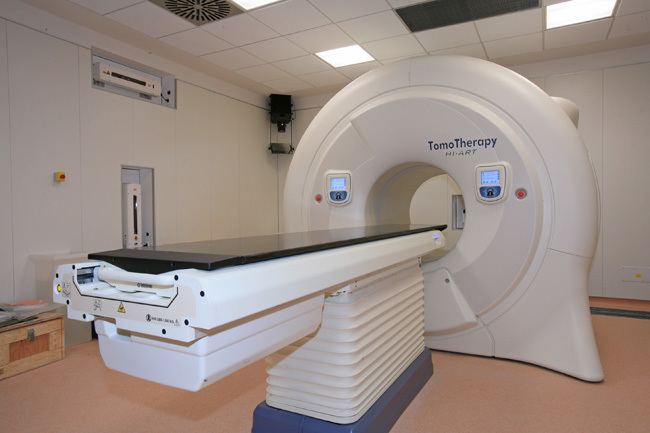 | ||
Tomotherapy or helical tomotherapy (HT) is a type of radiation therapy in which the radiation is delivered slice-by-slice (hence the use of the Greek prefix tomo-, which means "slice"). HT is a form of computed tomography (CT) guided intensity modulated radiation therapy (IMRT). HT machines are purpose built for IMRT and differ from IMRT delivered by conventional medical linear accelerators (LINACs) in a number of ways. The main difference is that in HT a narrow intensity modulated pencil beam is delivered from a rotating gantry while the patient is simultaneously moved through the bore, compared to the much wider intensity modulated beam and static patient in conventional IMRT. HT units are therefore better able to target treatment sites throughout the body without a pause for the patient to be moved and set-up differently.
Contents
History
The tomotherapy technique was developed in the early 1990s at the University of Wisconsin–Madison by Professor Thomas Rockwell Mackie and Paul Reckwerdt. A small megavoltage x-ray source was mounted in a similar fashion to a CT x-ray source, and the geometry provided the opportunity to provide CT images of the body in the treatment setup position. Although original plans were to include kilovoltage CT imaging, current models use megavoltage energies. With this combination, the unit was one of the first devices capable of providing modern image-guided radiation therapy (IGRT).
The first implementation of tomotherapy was the Corvus system developed by Nomos Corporation, with the first patient treated in April, 1994. This was the first commercial system for planning and delivering intensity modulated radiation therapy (IMRT). The original system, designed solely for use in the brain, incorporated a rigid skull-based fixation system to prevent patient motion between the delivery of each slice of radiation. But some users eschewed the fixation system and applied the technique to tumors in many different parts of the body.
General Principles
In general, radiation therapy (or radiotherapy) has developed with a strong reliance on homogeneity of dose throughout the tumor. Tomotherapy embodies the sequential delivery of radiation to different parts of the tumor which raises two important issues. First, this method is known as "field matching" and brings with it the possibility of a less-than-perfect match between two adjacent fields with a resultant hot and/or cold spot within the tumor. The second issue is that if the patient or tumor moves during this sequential delivery, then again, a hot or cold spot will result. The first problem is reduced by use of a helical motion, as in spiral computed tomography. The second requires close attention to the position of the target throughout treatment delivery.
At this time, the Hi-Art system manufactured by TomoTherapy Inc. is the primary tomotherapy device in use although there are still a number of Corvus systems being used. TomoTherapy TomoHD systems are also in use.
TomoTherapy "beam on" times vary compared to normal radiation therapy treatment times (HT irradiation time can be as low as 6.5 minutes for common prostate treatment) but do add an additional 2–3 minutes for a daily CT. The daily CT is used to precisely place the radiation beam and allows the operator to modify the treatment should the patient's anatomy change due to weight loss or tumor shrinkage (Image-guided radiation therapy). Lung cancer, head and neck tumors, breast cancer, prostate cancer, stereotactic radiosurgery(SRS) and stereotactic body radiotherapy (SBRT) are some examples of treatments commonly performed using tomotherapy. Some research has suggested HT provides more conformal treatment plans and decreased acute toxicity.
There are few head to head comparisons of HT and other IMRT techniques, however there is some evidence that VMAT can provide faster treatment while HT is better at sparing surrounding healthy tissue and providing a uniform dose.
Mobile tomotherapy
Due to their internal shielding and small footprint, TomoTherapy Hi-Art and TomoTherapy TomoHD treatment machines are the only high energy radiotherapy treatment machines used in relocatable radiotherapy treatment suites. Two different types of suites are available: TomoMobile developed by TomoTherapy Inc. which is a moveable truck and Pioneer, developed by UK-based Oncology Systems Limited. The latter was developed to meet the requirements of UK and European transport law requirements and is a contained unit that is placed on a concrete pad, delivering radiotherapy treatments in less than five weeks.
